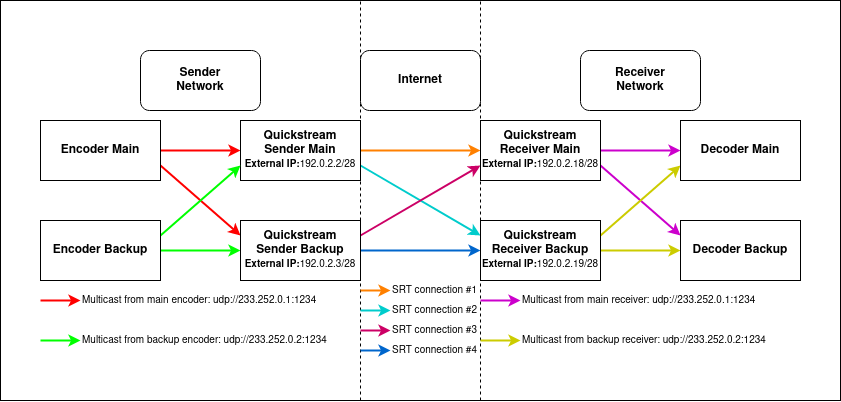High availability with two multicast input and output¶

Many Quickstream clients use configuration like this. It allows to send data through the Internet fully redundantly. It requires:
- Two independent UDP MPEG-TS multicast sources.
- Two Quickstream sender nodes.
- Two Quickstream receiver nodes.
- One or more UDP MPEG-TS receivers. They should support multicast main/backup configuration.
This scenario protects you against:
- Source loss
- Sender Node loss
- Receiver Node loss
Separate network providers are recommended for main and backup nodes unless your network is redundant using BGP routing, for example.
Sources on the sender side¶
Starting with the sender side. Let's assume that you have two independent UDP multicast MPEG-TS streams. Those streams could be from hardware encoder, playout, video mixer, etc. For example, the main multicast is udp://233.252.0.1:1234, and the backup multicast is udp://233.252.0.2:1234.
Now, you need to configure four SRT connections on two Quickstream Nodes. Documentation on how to install and configure is available in other documentation chapters.
SRT Connection on the sender side¶
Each connection has main and backup input and two direct outputs.
Configuration on main sender Quickstream Node¶
| Input/Output | Type | Connection |
|---|---|---|
| Main Input | UDP | 233.252.0.1:1234 |
| Backup Input | UDP | 233.252.0.2:1234 |
| Output 1 | SRT Listener | 192.0.2.2:5000 |
| Output 2 | SRT Listener | 192.0.2.2:6000 |
Configuration on backup sender Quickstream Node¶
| Input/Output | Type | Connection |
|---|---|---|
| Main Input | UDP | 233.252.0.2:1234 |
| Backup Input | UDP | 233.252.0.1:1234 |
| Output 1 | SRT Listener | 192.0.2.3:5000 |
| Output 2 | SRT Listener | 192.0.2.3:6000 |
SRT Connection on the receiver side¶
Each connection has main and backup input and one direct output.
Configuration on main receiver Quickstream Node¶
| Input/Output | Type | Connection |
|---|---|---|
| Main Input | SRT Listener | 192.0.2.2:5000 |
| Backup Input | SRT Listener | 192.0.2.3:5000 |
| Output 1 | UDP | 233.252.0.1:1234 |
Configuration on backup receiver Quickstream Node¶
| Input/Output | Type | Connection |
|---|---|---|
| Main Input | SRT Caller | 192.0.2.3:6000 |
| Backup Input | SRT Caller | 192.0.2.2:6000 |
| Output 1 | UDP | 233.252.0.2:1234 |
Outputs on the receiver side¶
On the receiver side, we configured only one output per channel because multicast has no redundancy unless you configure source-specific multicast. If we configure two multicast streams with the same destination IP address and destination port, they would interfere with each other. Simply, it would not work.
You can configure your receivers to use those two multicasts or manually switch between them.